Intel SSD 530 (240GB) Review
by Kristian Vättö on November 15, 2013 1:45 PM EST- Posted in
- Storage
- SSDs
- Intel
- Intel SSD 530
Random Read/Write Speed
The four corners of SSD performance are as follows: random read, random write, sequential read and sequential write speed. Random accesses are generally small in size, while sequential accesses tend to be larger and thus we have the four Iometer tests we use in all of our reviews.
Our first test writes 4KB in a completely random pattern over an 8GB space of the drive to simulate the sort of random access that you'd see on an OS drive (even this is more stressful than a normal desktop user would see). I perform three concurrent IOs and run the test for 3 minutes. The results reported are in average MB/s over the entire time. We use both standard pseudo randomly generated data for each write as well as fully random data to show you both the maximum and minimum performance offered by SandForce based drives in these tests. The average performance of SF drives will likely be somewhere in between the two values for each drive you see in the graphs. For an understanding of why this matters, read our original SandForce article.
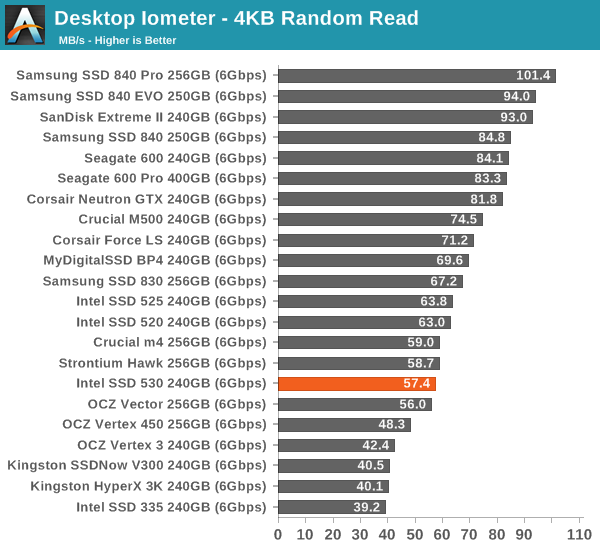
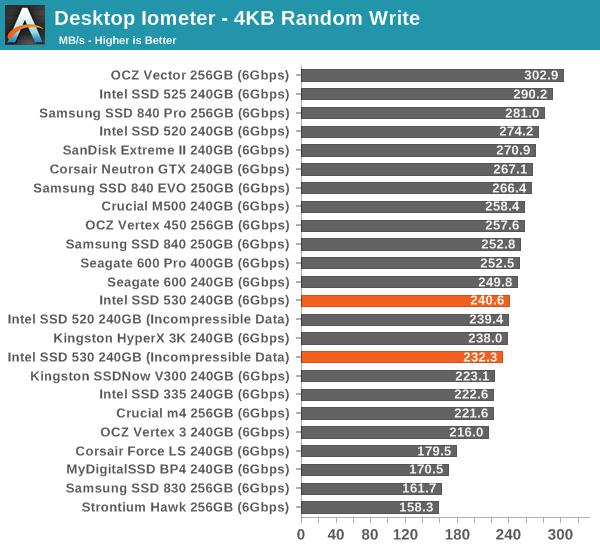
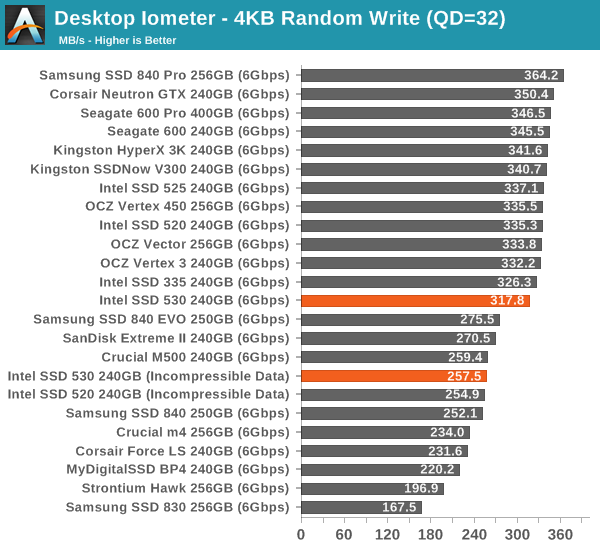
Random speeds are slightly down from SSD 520/525. The decrease could be NAND related as it's a fact that read and program times go up as we move to smaller lithographies, which will then translate to decrease in overall performance. However, compared to the SSD 335 performance is better but we're dealing with a higher bin of IMFT's 20nm NAND, so that's not a surprise.
Sequential Read/Write Speed
To measure sequential performance I ran a 1 minute long 128KB sequential test over the entire span of the drive at a queue depth of 1. The results reported are in average MB/s over the entire test length.
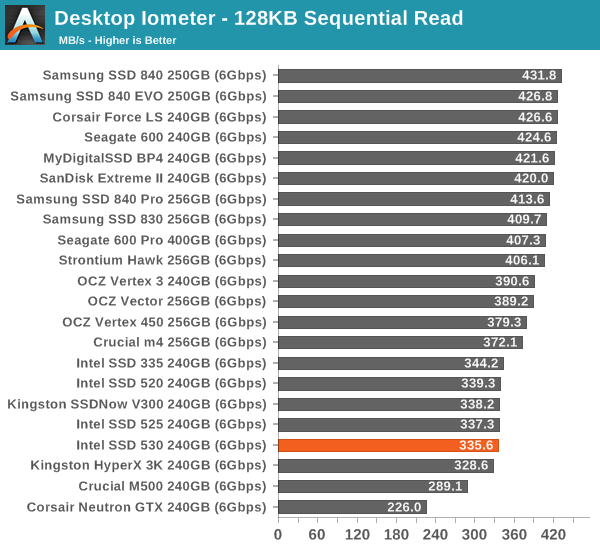
Read performance has never been one of SandForce's biggest strengths but write performance is top of the class (except when dealing with incompressible data).

AS-SSD Incompressible Sequential Read/Write Performance
The AS-SSD sequential benchmark uses incompressible data for all of its transfers. The result is a pretty big reduction in sequential write speed on SandForce based controllers.
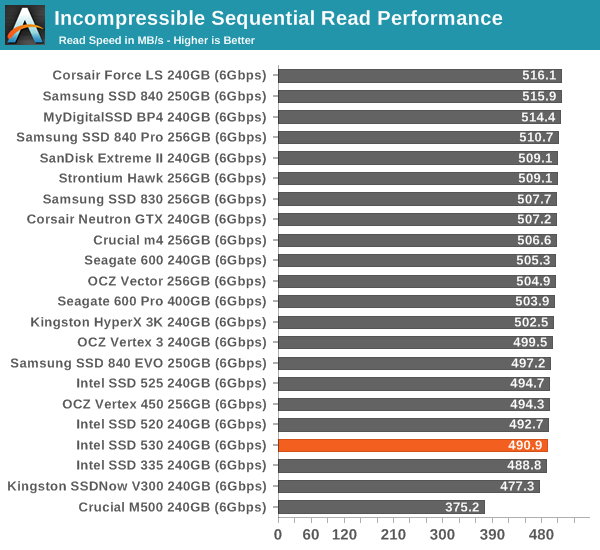
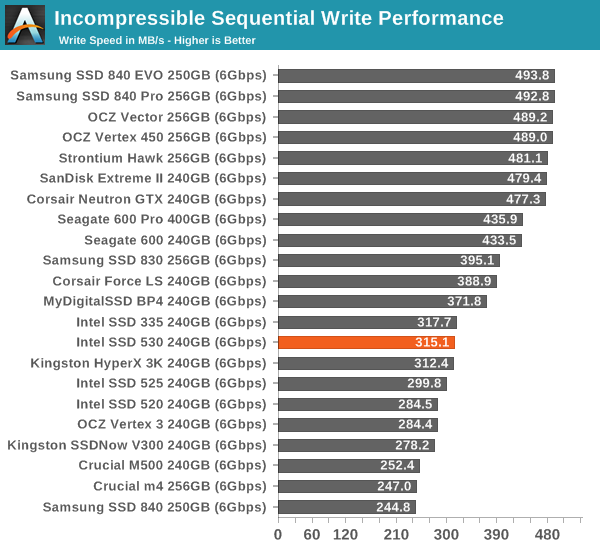










60 Comments
View All Comments
dynamited - Friday, November 15, 2013 - link
I count seven asus motherboards with mPCIE, not one, at newegg. Regarding 6bps sata saturated, just run with RAID 0, is that hard to figure out how to do?ExodusC - Friday, November 15, 2013 - link
I don't think TRIM commands can be passed through to SSDs running in RAID 0. At one point the Intel storage drivers supported this, but I heard that this had been pulled. I can't find any documentation on this.Additionally, even though SSDs are fairly reliable, adding another drive simply adds another point for failure.
Wetworkz - Friday, November 15, 2013 - link
You CAN pass TRIM commands through to SSDs running in Raid 0 on Intel hardware. It has NOT been pulled. You need to have the latest Intel Toolbox in combination with the latest RST drivers installed. I just TRIMMED both my arrays a couple days ago.ExodusC - Friday, November 15, 2013 - link
Out of curiosity, is that an automated process, or does it require manual TRIM through the Intel SSD Toolbox? What RAID levels are supported?I also wonder about the compressibility of striped data and if there is any effect there.
Samus - Friday, November 15, 2013 - link
I pass TRIM to my RAID 0 Samsung 840 RAID through the Windows 8 defrag on my H87 chipset. Performance tests prove it works. Unfortunately if I have the IRST software installed the drives are downgraded to SATA 3Gbps. I tried different cables and everything. Uninstalling the IRST software after making the RAID 0 restores them to 6Gbps...DMCalloway - Friday, November 15, 2013 - link
It was my understanding that TRIM worked in RAID 0 with the newer RST drivers, but only on Intel 7 series chipsets and newer. I do like Intel products but this is one thing they shafted us on.Wetworkz - Saturday, November 16, 2013 - link
I just TRIMMED both my arrays a few days ago and one array was on an Intel 6 series chipset. I know that series 6 was not previously supported but I was able to initiate TRIM on the array with the newest Intel Toolbox and the newest RST drivers for the first time the other day. I cannot confirm this is officially supported behavior but I was able to do it with the newest drivers. I would give it a try if you have a series 6 board.'nar - Monday, November 18, 2013 - link
I don't really care about TRIM. Garbage Collection works better anyway, especially on SandForce drives.extide - Friday, November 15, 2013 - link
mPCIE is not the same as M.2dynamited - Friday, November 15, 2013 - link
I believe they are calling it "mPCIe Combo Card" which actually has two connects to one on the motherboard.